Women in Conservation

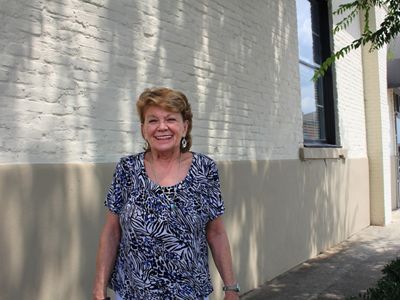
The Pioneer: Brusi Alexander
As The Nature Conservancy’s founding state director in South Carolina, LaBruce “Brusi” Alexander is a woman who gets things done. Just ask Ted Turner.
When Brusi Alexander was hired to direct The Nature Conservancy’s new South Carolina Chapter in 1977, she had one member and two pieces of furniture at her disposal.
“I brought my own desk and chair, but for a while my ‘credenza’ was a large shipping box I took from the grocery store,” she remembers.
With the help of that one member—Lindsay Pettus, from Lancaster—Brusi got to work building a board, a conservation agenda and a legacy.
1970s South Carolina was a challenging setting—“my landlord called us the nature controversy,” she notes—but Brusi dug in. She successfully lobbied for a documentary stamp tax legislation and a check box on state tax returns to fund conservation. Her first environmental protection effort was the well-known Midlands landmark Peachtree Rock Heritage Preserve.
“I thought I could just show up and tell the owner what a great conservation project we had in mind,” she says. “It turns out he had other plans for Peachtree and it took a bit more convincing.”
Quote: Brusi Alexander
I focused on the work. I was there to protect natural areas, and that’s what I was going to do.
Not even Ted Turner was safe from Brusi’s trademark persistence. Following weeks of calls—“I had some great conversations with his assistant,” she laughs—she finally was granted an appointment. And then almost missed the meeting.
“I got to the Columbia airport that morning, and they told me my plane wasn’t taking off. Eventually, I begged two businessmen from Chicago for a ride on their airplane. They didn’t even give me a seat; I rode in the aisle!”
After their meeting, Turner donated the first piece of property in one of South Carolina’s great conservation success stories, the ACE Basin.
Founding a statewide conservation organization is no easy feat, but it’s even more impressive when one considers the extra hurdles Brusi faced.
“Women were few and far between in any business at that time,” she says. “I was the only female state director at the Conservancy for a while. I had male developers say they didn’t want to deal with me.”
So how did she push through?
“I focused on the work. I was there to protect natural areas, and that’s what I was going to do.”
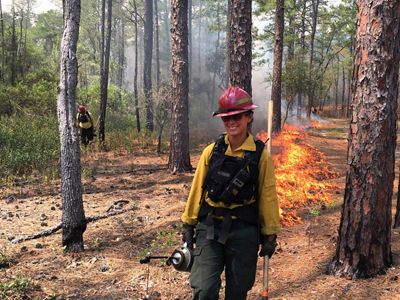
The Firefighter: Aisha Wiig
For wildlands firefighter Aisha Wiig, a curiosity about fire ignited a passion for controlled burning.
Think wildland firefighters grow immune to how cool their job is? Think again.
“Fire is why we do it,” admits Aisha Wiig. “When you put fire on the ground, it’s exciting.”
Aisha started as a firefighter “to make some extra cash” while working at an elementary school after college. It remained a side job for her until her crew switched from suppression work to controlled burning. Then it became a career.
“On a burn suppression crew, you put out a fire even when it’s providing ecological benefits, and that was hard for me,” she explains. “I believe in deepening the public’s understanding of the need for and benefits of controlled burning.”
After reading about The Nature Conservancy’s use of controlled burns, Aisha reached out to our prescribed fire training program. They put her in touch with Tom Dooley, the South Carolina Chapter’s state forest manager.
Quote: Aisha Wiig
Being a female in this world can be challenging, but there are never any lines for the women’s showers at fire camp!
“He said, ‘If you can get to South Carolina, you’re welcome to volunteer with us,’” she remembers. “I found a round-trip ticket for $200 and volunteered for two weeks in 2016.”
In 2017, Aisha joined the team as a full-time crew member. In 2018, she returned again—this time as crew lead.
“A crew lead supervises and coordinates the burn crew’s activities and makes sure the engine is ready to go,” she says. “I’ve learned so much.”
Learning opportunities are key for female firefighters, in particular. Mentors and role models can be scarce when crews typically only have one or two women on staff.
“Being a female in this world can be challenging,” says Aisha. “But there are never any lines for the women’s showers at fire camp! I like to joke about that.”
Women “can basically do the same work as guys” physically, she says, but having them on a crew often changes the dynamic—for the better.
“It’s less of a competition and more of a team when you have mixed gender crews,” she explains.

The Women of Boeing
From community outreach to legal counsel, these women are helping to shape an ambitious corporate conservation strategy that ranges from oysters to forests.
ASHLEY: I grew up in Charleston and come from a family of nature enthusiasts, so it was just in my blood to care about this place. It was exciting to find out that Boeing cared about the environment as much as I grew up caring about it.
LINDSAY: One of our ‘Boeing behaviors’ is to lead with courage and passion, and we’ve been trying to do that in the environmental space. We’ve taken a proactive approach to conservation and have been fortunate to be able to do this differently and be innovative.
LEAH: When we realized we’d need to do wetlands mitigation here, I felt strongly that our team needed to be in South Carolina and to do it right. Boeing didn’t question it. It didn’t come down to cost, it came down to wanting to give back to the community.
Quote: Jessica Jackson
Preserving where we all call home is of utmost importance to us.
JESSICA: That’s really how we look at corporate citizenship. We’re not about writing a check. It comes down to the intellectual capital we can offer and how we can bring organizations together for a common goal.
ASHLEY: Boeing could not have done this by ourselves. The conservation community in South Carolina is amazing, the way they work together…
LINDSAY: And the way they’ve worked with us!
JESSICA Our teammates all have families, all live here. Preserving where we all call home is of utmost importance to us. It’s important to get them involved, and that’s why we love building oyster castles with The Nature Conservancy. I know now that an oyster the size of my hand can filter 50 gallons of water per day, and that oyster reefs help 130 species.
KELLEY Our teammates can read about what Boeing is doing all over the world, but it’s really about getting them out there to do these hands-on projects, so they can see what they’re building and even go back to what we did last year and see the growth. We’ve built three oyster reefs so far and those are by far our most popular events.
LINDSAY When you do something like this, you don’t do it for a decade. You do it for the next 100 years.
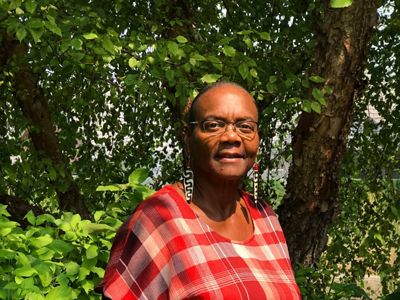
The Scientist: Zelma Jackson-Maine
From learning traditional midwifery from her grandmother, to searching for uranium deposits in the rocks of Montana, the earth is in Zelma Jackson-Maine’s blood.
“I probably dropped out of my mother’s womb as an environmentalist,” muses Zelma Jackson-Maine. “I always was interested in why butterflies were different colors, why grass grew and why we had red clay and black dirt.”
As a child, Zelma got her answers from her grandmother, Hannah Maine.
“She was the community’s midwife,” says Zelma. “Geechee children are often nurtured by grandparents to give them wisdom. I lived with her until I was seven.”
Hannah also introduced Zelma to science.
“If a woman was iron-deficient, my grandmother would send us children to a certain clay bank to get red clay for her, which has iron in it,” she remembers. “I was at her knees all the time, asking questions, and she would explain it to me.”
At age seven, Zelma went to live with her parents at the U.S. Army Base in Heilbronn, Germany. The science-based curriculum there, as well as her resultant fluency in German, later made her an ideal candidate for an integration program pioneered by Atlantic Richfield Company, Shell, ConocoPhillips and ExxonMobil (then separate companies), as well as the American Geological Society.
Quote: Zelma Jackson-Maine
Now I’m looking at my granddaughter and great-granddaughter and saying, ‘What future have I left behind?’
“They decided it was time to bring women into the field, specifically African-American women,” says Zelma. “They paid for our undergraduate education, and during the summer, we would go to Texas on an oil field or Wyoming on uranium exploration.”
After a stint at the Hanford Site, a now-decommissioned nuclear production facility in Washington, Zelma found herself back outside “chopping on rocks” at Mount Baker in the North Cascades. She was still there, pursuing a master’s degree, when Mount St. Helens erupted in 1980, only 300 miles to the south.
“I lost a few friends in that eruption,” she remembers. “We weren’t volcanologists. We never thought that would happen.”
Zelma’s zeal for uranium exploration cooled in the late 1980s, when she began to wonder how future generations would deal with the radioactive material being created.
“We can’t put the genie back in the bottle,” she notes. “Now I’m looking at my granddaughter and great-granddaughter and saying, ‘What future have I left behind?’”
The state of the future is a challenge Zelma is working to address, both professionally and as a trustee for The Nature Conservancy. But one obstacle she hopes her descendants won’t have to face? Being one of the first women in their chosen fields.
“My view was always that people would get with it, or they could get out of my way,” she says.
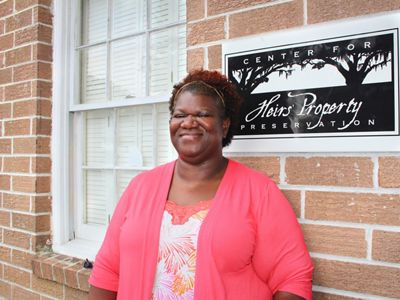
The Advocate: Jennie Stephens
“I like helping folk, and I don’t like injustice.” It’s a sentiment many of us share, but few are as driven, determined and effective in applying it as Jennie Stephens.
Jennie Stephens knows something about the power of identity. As the executive director for the Center for Heirs’ Property Preservation, she provides a bridge between underserved communities and legal and business systems that historically haven’t treated them fairly.
“Inheritance and land use can be a difficult conversation to have,” she acknowledges. “There’s a history of these landowners being taken advantage of.”
Heirs’ property is land that has been passed down to living beneficiaries without a formal will. A simple division of land quickly becomes complicated as children, grandchildren and remarriages broaden a family’s tree.
“In South Carolina, it is believed that most heirs’ property belongs to African-Americans, purchased by freed slaves after the Civil War,” Jennie explains.
“But it exists all over the country, among populations of underserved landowners.”
Quote: Jennie Stephens
For any woman doing something unique or different, there are challenges. But we are all chosen for a purpose, and this is mine.
Jennie has strong roots in the communities in which she works, but becoming the Center’s director thrust her into a new professional cohort that was slow to warm up.
“I spent my first years learning about law to get attorneys to support us,” she remembers.
Today, the Center employs four attorneys and many more volunteer there, providing educational seminars and pro-bono writing of simple wills.
While the Center has cleared nearly 200 titles since 2005—a land value of more than $12 million—the organization still faces a persistent question: What do the heirs do with their lands once their title issues are resolved?
“We think of land as an asset, but for many heirs the taxes make it a liability,” she says. “Selling may seem like the only way to recoup those costs.”
Working with The Nature Conservancy, the U.S. Endowment for Forestry and Communities, Clemson University and local land trusts, the Center launched a sustainable forestry program that advises heirs how to manage—and create income from—their lands.
Jennie’s “alternative strategy of conservation,” as she calls it, has been a boon for the communities she serves.
But, again, it singled her out.
“I’m a woman of color working in the environmental field, where most people don’t look like me,” she says. “For any woman doing something unique or different, there are challenges. But we are all chosen for a purpose, and this is mine.”
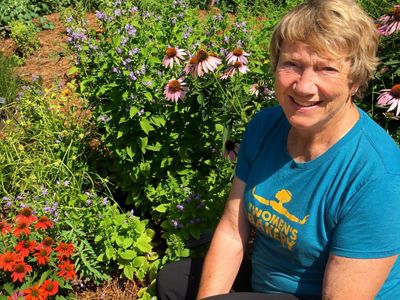
The Native Gardener: Ann Baruch
Co-Founder of Spring Island’s Native Plant Project, Ann Baruch is a self-taught advocate for South Carolina’s indigenous plants.
If you see Ann Baruch around Spring Island, chances are she is a little dirty and carrying clippers, a trowel and a bag for seeds. Ann has become a native plant ambassador, bringing South Carolina native plants from anonymity into Lowcountry gardens.
“I’ve always been a gardener, but before I came to Spring Island in 1999, I had little understanding of native plants,” Ann says. She bought the lot next door to hers and contacted landscape architect Thomas Angell to help her create a native plant garden.
“He would identify native plants that were already growing on my property and encourage me to collect their seeds,” says Ann. “I would explore Spring Island in the spring and summer and see plants with beautiful flowers. In the fall, I returned to collect their seeds.”
The garden’s inventory grew quickly. It now spans one-third of an acre and contains approximately 175 different native plants and cultivars.
“I consider each of my plants a friend,” says Ann. “Every morning, I walk out with a cup of coffee to see how they look.”
Quote: Ann Baruch
Each of us can contribute to our precious planet.
Ann soon noticed hundreds of seedlings would sprout around the base of certain plants every spring. An idea took root.
“I thought, ‘We could pot them and sell them,’” she remembers. “We could collect the seeds of many other plants, germinate them and sell the offspring. What a great way to make native plants available to other gardeners and earn support for the Spring Island Trust at the same time! Ten years later, 70 volunteers help us put on two big sales per year, and our shoppers come from all over Beaufort County.”
So what are some of her favorites?
- “I love the spring ephemerals— trillium, bloodroot and atamasco lilies.”
- “Ferns. I have five or six different varieties in my garden.”
- “The native azaleas light up the garden with spectacular color.”
- “The milkweeds (asclepias) are wonderful because they attract monarch butterflies.”
- “A special favorite is Indian Pink (spigelia marylandrica).”
Ann’s desire to introduce others to South Carolina’s natural wonders also brought her to The Nature Conservancy. She has served on the state chapter’s board since 2009, organizing field trips, hosting events and fundraising. This past summer, she attended her first Conservancy Volunteer Leadership Summit in Washington, D.C., which brought trustees together from all over the globe.
“I was thrilled to meet so many influential and like-minded people,” she says. “The impact of the Conservancy’s work is deep and worldwide. Each of us can contribute to our precious planet.”
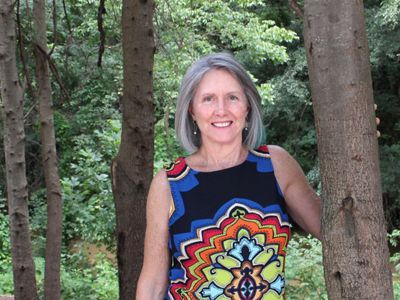
The Explorer: Victoria McGinnis
Victoria McGinnis likes to experience things firsthand. She’s traveled and lived all over the world; now she’s doing her part to make sure its wonders remain for future generations.
If the pop of turquoise in Victoria’s hair makes you think she leads a fascinating life, you’re right. Victoria has lived more places than most people have traveled.
“We like to move,” Victoria says of herself and her husband, Jim. “Probably our most adventurous one was the year we spent in Ecuador. We purged a lot, put stuff in storage, then drove to the airport with 10 suitcases and a cat.”
Listen to Victoria describe the places she’s lived, and you’ll wonder why she ever left. From the local farmers she befriended in rural Virginia—“it really taught me about land stewardship,” she says—to the bayous she and Jim explored while living outside New Orleans, La., it’s clear that the lands, wildlife and people from each place have impacted her deeply.
Quote: Victoria McGinnis
I want to protect nature and animals for future generations. This is the way I hope to make a bit of difference.
“So many people are born and stay in the same community their whole lives,” she notes. “I always tell people, ‘Move somewhere. Travel.’ Or you miss so much.”
Where is she most eager to return?
“The Amazon,” she answers, without hesitation. “There was every kind of exotic bird, howler monkeys, squirrel monkeys, you name it. The place we stayed had a canopy walk, where you could climb these tall metal towers and look out over the trees.”
Just as interesting to Victoria and Jim was the intersection of cultures on display.
“It was wild to see these huge barges moving down the river next to subsistence fishermen in their small canoes,” she remembers. “It makes you think about how much we depend on the environment.”
That same feeling drove Victoria to volunteer for The Nature Conservancy and include the Conservancy in her estate plans.
“Whatever is left, I want it to go to something,” she says. “I want to protect nature and animals for future generations. This is the way I hope to make a bit of difference.”
You Can Make a Difference in South Carolina
When you give today, you’re helping South Carolina’s future generations.